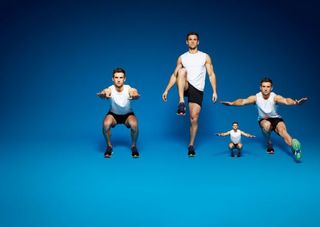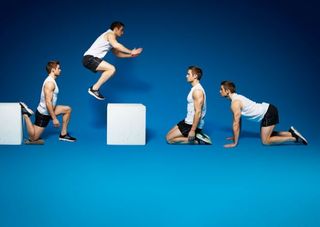7 quick injury prevention exercises
Improve your personal bests with 7 quick exercises that will keep you injury-free by improving mobility

If your self-improvement plan reads ‘harder/faster/heavier/more,’ you’re bound to injure yourself. Recent studies suggests that one in two runners injure themselves every year, and the numbers aren’t better for gym-goers. But there’s an upside: with a little more attention to how you move, and not how much, you’ll make instant improvements – injury-free.
Your assessment starts here:
There's no need for a warm-up, just do these seven tests in order. Make a note of how you do, then pick one standard to improve over the next seven days – studies show that small habits stick faster. And watch your PBs fall…

1) Strength and endurance
Start with your feet shoulder-width apart, and squat Tabata-style: 20 seconds of work, ten seconds of rest, repeat eight times. Keep your back straight and knees in line with your feet. How do you get on?
A. Fewer than 10 squats per interval
B. 10+ squats per interval, but my form gets wobbly
C. 10+ squats per interval, with textbook form
‘A proper squat is all about good hip and ankle function,’ says mobility expert Dr Kelly Starrett. ‘The Tabata protocol is a good way to introduce fatigue without injury.’ Can’t manage it? ‘Hang out in the squat,’ says Starrett. ‘Get into the bottom position – your knees shouldn’t be ahead of your toes – and stay there for ten minutes. If you need to, split it into chunks.’ And yes, you can do it while you watch TV.
Get the Coach Newsletter
Sign up for workout ideas, training advice, reviews of the latest gear and more.
2) Balance
Stand on one leg, feet pointing forward, and pull your knee to your chest. Drop your hands and try to keep your knee in the same place for 30 seconds. Then switch. Can you manage it?
A. No
B. Just about, for one leg
C. Yes, for both legs
Research published in the Clinical Journal of Sports Medicine suggests that most chronic running injuries are due to weak hip flexors and come from a sedentary lifestyle, which is why ultradistance runners such as Dean Karnazes use standing desks. Not an option? Make sure you get up every 15 minutes and ‘brace’ – flex your glutes and abs slightly, then keep your core tight as you sit down.
3) Ankle mobility
This move is a variation of the classic pistol. Drop into a squat with your feet together, pressing your knees out, then extend one leg, keeping your standing foot flat. How does that work out for you?
A. I can’t do it. At all
B. OK, but my heel comes off the ground
C. I can do it on both sides
‘If you’re limited in dorsiflexion – flexing your foot – you’re missing out on a heap of elastic recoil that translates into power and speed,’ says Starrett. ‘Any time you go up a flight of stairs, stretch your calves. Spend 30 seconds with one foot on a step, your heel lowered, feeling the stretch.’

4) Hip mobility
Get on all fours in front of a wall and place one knee at the base of the wall so your shin is up against it (use a towel if the floor’s hard). Draw your other knee up and plant your foot. Drive your hip towards the floor and hold for as long as you can. After a minute, raise your torso upright. How’s it feel?
A. Honestly? I can’t do this
B. I can do the first bit but I can’t bring my body upright
C. All fine
‘I call this the couch stretch and it’s a weapons-grade technique for opening up the hip,’ says Starrett. ‘If you’re too tight to get into it, scale it back by putting a box in front of you. Put your weight on the box but don’t plant your leg, doing this daily for at least two minutes on each side will effect the tissue change you need to improve your posture, both when running and in everyday life.’
5) Jumping and landing
For this move you’re going to jump onto a box – but there’s a catch. Can you land with your feet pointing straight forward and your knees driving slightly outward?
A. No, my knees collapse inward
B. No, my feet spread out when I land
C. Yes, I jump like a gazelle
‘Jumping and landing with good mechanics is central to almost any kind of movement,’ says mobility expert Jill Miller, creator of Yoga Tune-Up. ‘Dancers practise them all the time thinking about every shape and every detail.’ That’s a start, but skipping is your other secret weapon, Get a speedrope and make a three-minute routine part of your warm-ups.
6) Plantar flexion
Get into a kneeling position with your heels under your glutes and your feet pointing straight back. That’s OK, right?
A. Wrong
B. Just about, but keeping my feet straight is tricky
C. It’s totally fine
‘Spending time in this position will work wonders for the shortened fascia in your feet and ankles,’ says Miller. Alternatively, stand on a lacrosse ball with one foot and work the ball up and down your arch, using your bodyweight to apply pressure and paying particular attention to any knots you find.
7) Shoulder mobility
Get on your hands and knees, with your shoulders directly above your wrists. Without moving the rest of your body, push into the ground with your hands and push your upper back towards the ceiling. Hold for five seconds, then relax and repeat. How’s that?
A. Almost impossible
B. All right, but a bit tiring
C. Fine
‘If you spend too much time in front of a computer, you’re likely to end up with scapular mobility problems’ says physical therapist Jarlo Ilano of Gold Medal Bodies. The stretch above is the fix – but if you find it too easy, do the same move from a press-up position instead.
YOUR PERFORMANCE ASSESSMENT
Mostly As
This might seem like bad news, but there’s a silver lining: your less-than-stellar mobility means performance gains will be easy to come by. Set aside ten minutes a day to work on your weaknesses, and watch your 10K time tumble.
Mostly Bs
You’re in good shape. A few minor tweaks will fix you up, and you’ll be on course for greatness. Use the RescueTime app to salvage a few minutes of your day to fix yourself up.
Mostly Cs
Nice work – you’re a mobility machine. That means you can push yourself harder with less fear of injury. Download the Strava app and take on the world.
From 2008 to 2018, Joel worked for Men's Fitness, which predated, and then shared a website with, Coach. Though he spent years running the hills of Bath, he’s since ditched his trainers for a succession of Converse high-tops, since they’re better suited to his love of pulling vans, lifting cars, and hefting logs in a succession of strongman competitions.

